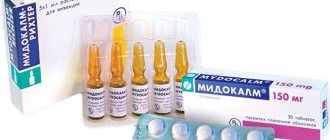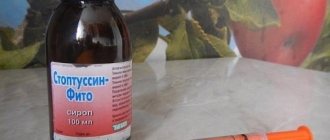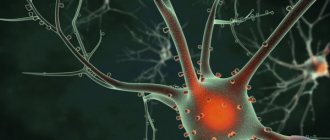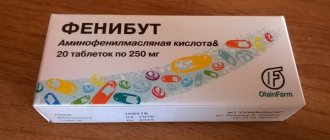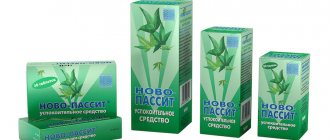"Mydocalm" is a drug that is very widely used in a variety of areas: from sports medicine to the rehabilitation of patients after a stroke, from the treatment of Raynaud's syndrome and disease to seizures, from lumbar osteochondrosis to multiple sclerosis. At first glance, all these diseases are unrelated to each other. But in fact, they (and many others) are united by the participation of the muscle component in the development of the disease - it is with the muscles that Mydocalm “works”.
This drug is original, and it was created by the Hungarian pharmaceutical company A. O. Gedeon Richter,” who owns all rights to the trademark and production technology. This company produces many different medicines, for example the well-known Cavinton. What structures in the human body are affected by Mydocalm, and what is the reason for its therapeutic effect?
general description
Mydocalm is a centrally acting muscle relaxant. It is distinguished from other drugs in this group by its effect directly on the central nervous system, which receives a signal to reduce the level of tension in muscle tissue. However, the principle of its action is not completely known.
The drug in the form of tablets and solution blocks certain types of signals in the central nervous system, which significantly reduces reflexes and stimulates local blood flow. In addition to the main one, the drug also has antispasmodic and antiadrenergic effects.
Indications for the use of the medicine are the following conditions:
- increased muscle tone, contractures, spasms - with arthrosis, lumbago, spondylosis, cervical syndrome, spondyloarthrosis;
- after traumatological and orthopedic operations;
- some organic diseases in which there is an increase in the tone of the striated muscles;
- combined treatment for arteriosclerosis, diabetic angiopathy;
- Little's disease or spastic cerebral palsy.
The main active ingredient is tolperisone hydrochloride. But what distinguishes tablets and injections are the excipients. The solution additionally contains the anesthetic lidocaine.
The tablets contain the following components:
- starch;
- talc;
- silica;
- stearic acid;
- microcrystalline cellulose;
- lactose;
- citric acid monohydrates.
The medicine is produced by the Hungarian company Gedeon Richter. There is also a Russian version of the muscle relaxant, which is produced under license. The product is available by prescription.
Active ingredient - how does it work?
Mydocalm tablets and ampoules
The active ingredient is tolperisone, its molecule is made highly soluble in water (and therefore in the blood) using chlorination. Therefore, Mydocalm is tolperisone hydrochloride. The drug is a centrally acting muscle relaxant. What it is?
A muscle relaxant is a substance that can relax muscles. With relaxation, it is possible to improve blood flow to the muscles and relieve painful spasms. But the main thing is that Mydocalm helps reduce muscle tone. It is known that muscles normally have some physiological tone. That is why, at rest, our arms and legs do not dangle like a wooden doll on hinges, and the joints do not dislocate. But in some cases, the tone increases, the muscle contracts and becomes denser. If the tone is constantly elevated, you need to reduce it, returning it to normal. This is what Mydocalm does.
It is known that muscle tone is regulated not only in the muscle itself. The main regulator is the brain and spinal cord, that is, the central nervous system. And therefore, Mydocalm is a centrally acting muscle relaxant. It affects the centers regulating muscle tone, which are located in the brain and spinal cord. First of all, this is the reticular formation and the lateral horns of the spinal cord.
At the same time, the drug molecule was selected by scientists so successfully that tolperisone does not affect the smooth muscles of internal organs (intestines, gall bladder), and does not affect the heart muscle.
In addition, Mydocalm slightly anesthetizes and inhibits the conduction of nerve impulses to the muscles. Able to increase blood flow in muscle tissue. For what diseases is the medicine prescribed, and in what forms is it available?
Research and effectiveness
Neurologist F.I. Devlikamova in her work “Study of the effectiveness of the drug Mydocalm-Richter in local injection therapy of the myofascial trigger zone” described the results of using the drug for myofascial pain syndromes. A study involving 20 patients showed positive pain-relieving and muscle-relaxing effects. It was also found that the use of Mydocalm accelerates recovery in diseases that are accompanied by muscle spasms.
Researcher of the neurological department and candidate of medical sciences A. V. Astapenko in the work “Mydocalm in clinical practice: effectiveness and safety” cited the data of her study. 1690 people took part in it. As a result, it was found that the use of Mydocalm in injections is effective for children and adults with muscular-tonic syndrome, degenerative processes in the spine and spasticity of central origin. The drug has also been proven to be highly safe in tablet and injection forms.
Preclinical studies of the drug showed that it does not have a teratogenic effect. However, clinical trials have not been conducted, so the medicine is prescribed to pregnant women when urgently needed, especially in the first trimester. Mydocalm is not used during breastfeeding, since there is no data on the penetration of the active substance into milk.
Which form should be used by whom?
It is recommended to ask the attending physician who prescribed this drug which form should be used. Both forms are effective and have much in common . For the treatment of children under 18 years of age, it is worth choosing Mydocalm tablets.
Acute conditions should be treated with injections . Capsules are more suitable as maintenance therapy. For people who have lactose deficiency, it is better to use Mydocalm in the form of injections.
- Tolisor or Mydocalm, which is better?
- Mydocalm, how to inject intramuscularly?
- Mydocalm or tolperisone, which is better?
- Tablets for memory and attentiveness for adults are the most...
- Ursosan or Heptral, which is better, doctors' opinion
- A toothache, what to do at home to...
- Ciprolet and Ciprofloxacin, what is the difference, which is better,...
- What is better nitroxoline or furadonin for cystitis?
Side effects
Undesirable symptoms occur more often when using Mydocalm injections. In this case, the doctor considers the option of switching to a tablet drug. There is a possibility of allergies, to prevent which it is recommended to administer the solution dropwise rather than in a stream. It is also necessary to take into account that the injections contain lidocaine, which has its own side effects.
Possible undesirable symptoms from using Mydocalm:
- decrease in blood pressure;
- headache;
- muscle weakness;
- discomfort in the stomach, nausea;
- hypersensitivity reactions - itching, bronchospasm, laryngeal edema, erythema.
Additionally for injections due to the content of an anesthetic component:
- anxiety, disorientation, confusion;
- tachycardia, bradycardia;
- backache;
- dizziness, feeling of euphoria.
Adverse reactions usually go away when the dosage is reduced. When treating at home, when such symptoms appear, you should stop using the product and consult a doctor.
Mydocalm injections
Available in the form of a solution intended for injection . The liquid is transparent, has a greenish tint and a specific odor. Intended for intravenous and intramuscular injections. Packaged in ampoules.
The active substance is tolperisone hydrochloride . It is contained in a concentration of 100 mg . The therapeutic effect is also achieved with lidocaine hydrochloride. This component is present in an amount of 2.5 mg. Additionally, the preparation contains purified water, diethylene glycol monoethyl ether, and methyl parahydroxybenzoate.
Tolperisone hydrochloride has muscle relaxant properties.
The drug is used in the treatment of such pathologies:
- Thromboangiitis obliterans.
- Diffuse scleroderma.
- Raynaud's disease.
- Obliterating atherosclerosis.
- Diabetic angiopathy.
- Little's disease.
- Arthrosis of the joints.
- Encephalomyelitis.
- Spondyloarthrosis.
- Cervical syndrome.
- Multiple sclerosis.
- Disorders of vascular innervation.
Mydocalm or tolperisone, which is better?
You should not undergo therapy with this medication in the following cases:
- Age up to 18 years.
- Intolerance to the composition.
- Pregnancy.
- Severe forms of myasthenia.
- Breast-feeding.
- Liver and kidney failure (relative contraindication).
Ignoring these prohibitions may result in the development of the following side effects:
- Allergy.
- Headache.
- Hypotension.
- Nausea, urge to vomit.
- Discomfortable sensations in the abdomen.
- Muscle weakness.
- Dizziness.
The solution is administered intramuscularly twice a day, and intravenously once a day. The optimal dosage is selected by the doctor individually. As a rule, the daily dose is equal to one ampoule.
Dosage
Mydocalm tablets are taken orally, not chewed, washed down with clean water. From 14 years of age, the average dosage is 50 mg up to 3 times, from 3 to 6 years – 5 mg/kg 3 times, from 7 to 14 years – 2-4 mg/kg 3 times. It is recommended to take the tablets with meals.
Injections are prescribed only to adults; for children over 5 years of age, injections are given when absolutely necessary. 100 mg is administered intramuscularly 2 times, intravenously - 100 mg 1 time.
Kidney disease usually requires a dosage reduction. This is especially true for injections. In this group of patients, side effects are common. If treatment is necessary, the patient should be under the supervision of a physician. This also applies to people with liver pathologies.
There have been no reports of overdose of the drug in injections or tablets. The use of the drug for children at a dose of 600 mg without severe side effects is described. At a dosage of 300-600 mg, increased irritability is observed in some cases.
Animal studies have shown that large doses can cause incoordination, seizures, and paralysis of the respiratory muscles. There is no antidote for overdose. To eliminate side effects, symptomatic therapy is carried out. The victim needs to rinse his stomach and take enterosorbent.
Drug interactions
There is no information about interactions that limit the use of the drug in question. However, it should be noted that tolperisone has an effect on the central nervous system. At the same time, the drug does not cause drowsiness, so it can be combined with sleeping pills and sedatives, as well as medications containing ethanol.
When taken simultaneously, Mydocalm enhances the effect of niflumic acid. If it is necessary to combine such agents, it may be necessary to reduce the dose of the latter.
Peripheral muscle relaxants, drugs for general anesthesia and psychotropic drugs, as well as Clonidine, enhance the effectiveness of tolperisone.
Cost and analogues
Comparison of the cost of different forms of release and analogues of Mydocalm:
| Release form | Price | Analogs |
| Pills | 150 mg No. 30 – from 370 rubles; 50 mg No. 30 – from 340 rubles | Miaxil; Midostad; Toccata; Tolperil; Baclofen |
| Injections | 1 ml No. 5 – from 480 rubles |
Which release form is better?
Mydocalm tablets are effectively used in complex treatment for chronic diseases associated with muscle spasms and pain. They can be prescribed in childhood. Injections are best used only for adults during the acute period of the disease. Gradually they can be replaced by a tablet drug.
The choice of the form of release of the medicine is made by the doctor when prescribing treatment. Various factors are taken into account, including age, history of allergies, and gastrointestinal condition. Taking the drug on your own is dangerous, as there are contraindications and the risk of severe adverse reactions.
Comparison: differences
These forms have certain differences.
They are as follows:
- Different composition of auxiliary components.
- The injections additionally contain lidocaine.
- The injections help faster and cause less side effects.
- Tablets can be given to children, injections are given only to adults.
Mydocalm, how to inject intramuscularly?
